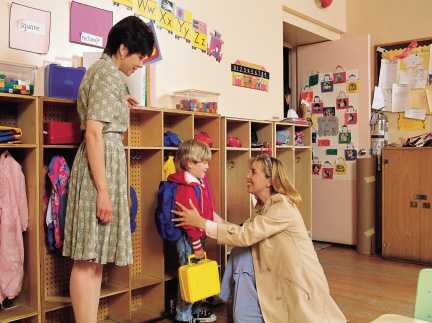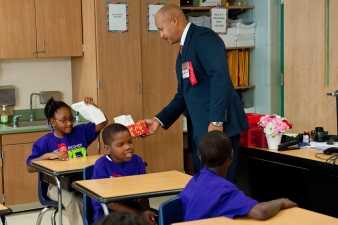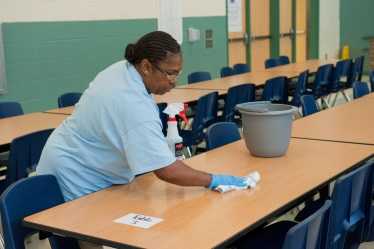Administrators of Childcare and K-12 Schools
Flu Prevention at School

When children are close together, there is an increased risk that they will spread respiratory illnesses like the flu to each other. The risk is especially high among infants and toddlers, who are likely to share toys that may have been in their hands or mouths. Children are also more likely than adults to get sick from the flu and more likely to spread it to others, including their families. For children, flu is more dangerous than the common cold. Each year, many children get sick with seasonal flu; some of those illnesses result in death.
Getting the flu vaccine every year is the best way to prevent seasonal flu. Nonpharmaceutical Interventions (NPIs) can also help people protect themselves and others from getting and spreading the flu. NPIs are especially important during outbreaks of pandemic flu.
A pandemic flu outbreak occurs when a new strain of influenza virus appears among people. Because it is a new virus, we have little or no immunity to it. This allows the virus to spread quickly from person to person around the world. It may take months before an effective vaccine is developed.
- What you can do personally ( Personal NPIs): Stay home when you are sick. Cover your coughs and sneezes. Wash your hands often.
- What communities can do ( Community NPIs): Implement social distancing interventions in schools, workplaces, and at events.
- What everyone can do to keep the environment germ-free ( Environmental NPIs) : Clean frequently touched surfaces and objects like door knobs.
- CDC provides educational resources and training on how to incorporate personal, community, and environmental NPIs into your pandemic flu plans.
The actions your school takes and the plans you make today make a difference. Here are some important steps to protect yourself and others from getting and spreading the flu at school:
1. Being prepared and informed.
What to do:

- Know where and when the seasonal flu vaccine is being offered.
- Stay informed about your local flu situation, including possible closures in nearby school districts.
- Know school district policies on maintaining school lunch programs and handling sick children.
- Coordinate plans with state, tribal, local, and territorial public health officials.
* During a flu pandemic *
- Make plans for what to do in the event that your local public health department or school district recommends closing schools or canceling events.
- Get the pandemic flu vaccine as soon as it becomes available in your area.
2. Teaching students and staff about flu prevention.

Teaching students and staff about flu prevention through class activities, visits with the school nurse, websites, letters, posters, and announcements.
- Encourage parents, students and staff to get the seasonal flu vaccine.
- Educate parents, students and staff about everyday preventive actions, such as staying home when sick, covering coughs and sneezes, and washing their hands often.
- Encourage families to clean surfaces and objects that are touched frequently at home.
- Use staff training and routine business communications, such as email, to
- Encourage staff to get the seasonal flu vaccine.
- Encourage staff to take everyday preventive actions, such as staying home when sick, covering coughs and sneezes, and washing hands often.
- Encourage staff to clean frequently touched surfaces and objects.
- Inform staff about sick-leave policies.
- Inform parents about attendance policies.
- Reinforce the importance of people staying home when they are sick. Discourage perfect attendance awards.
* During a flu pandemic *
- Encourage staff to get the pandemic flu vaccine as soon as it becomes available in your area.
- Consider canceling extracurricular events, such as sports practices and club meetings.
- Urge students, parents, and staff to stay at home if sick and if schools are closed. Students, parents, and staff should avoid gathering in other places when schools are closed.
- If children and teenagers must gather, keep them in small groups of fewer than 6 people. Encourage these groups to limit themselves to the same children each day.
Provide additional staff training that includes
- Cross-training staff to ensure coverage in case people get sick and need to stay home.
- Separating sick people from healthy people, and sending sick people home as soon as possible.
3. Maintaining a clean environment and providing students and teachers with supplies that prevent the spread of flu.

- Clean surfaces and objects that are frequently touched, such as toys, desks, keyboards, and doorknobs.
- Provide supplies that promote healthy hygiene, including tissues, soap, and hand sanitizer.
4. Building flu prevention into the operations and planning of your childcare facility or school.

- Connect with your local board of education and public health department to establish or review the pandemic flu plan for your community.
- Develop an emergency communication plan for sharing information with staff, parents, and students during a flu pandemic.
- Share the pandemic flu and emergency communication plans with staff.
- Support flexible attendance and sick leave policies for students and staff.
- Develop a system to alert the local public health department about large increases in absenteeism due to flu-like symptoms.
- Identify ways to continue student education if schools close for an extended period (for example, take-home lesson plans, web-based instruction, email, or television).
- Work with partners to ensure that social, medical, and meal services will continue for eligible students if schools close.
- Designate a separate room and transportation for sick students and staff, if necessary.
Flu Prevention Tools and Resources for School Administrators
Educational Materials
- Get Your School Ready for Pandemic Flu [PDF – 16 pages]
- Get Your Community Ready for Pandemic Influenza Using Nonpharmaceutical Interventions [PDF – 17 pages]
- Pan Flu Checklist: Childcare Program Administrators [PDF – 1 page]
- Pan Flu Checklist: K-12 School Administrators [PDF – 1 page]
- How To Clean and Disinfect Schools To Help Slow the Spread of Flu
Selected Published Research
The following published research includes studies on NPIs conducted by researchers within the past 5 years that are published in peer-reviewed journals. (In alphabetical order by topic.)
School Closure
- Braunack-Mayer A, Tooher R, Collins JE, Street JM, Marshall H. Understanding the school community’s response to school closures during the H1N12009 influenza pandemic. BMC Public Health 2013; 13:344.
- Jackson C, Vynnycky E, Hawker J, Olowokure B, Mangtani P. School closures and influenza: systematic review of epidemiological studies. BMJ Open 2013; 3(2).
- Mizumoto K, Yamamoto T, Nishiura H. Contact behaviour of children and parental employment behaviour during school closures against the pandemic influenza A (H1N1-2009) in Japan. J Int Med Res 2013; 41(3):716-24.
Guidance
- Page last reviewed: August 2, 2017
- Page last updated: August 2, 2017
- Content source:


 ShareCompartir
ShareCompartir